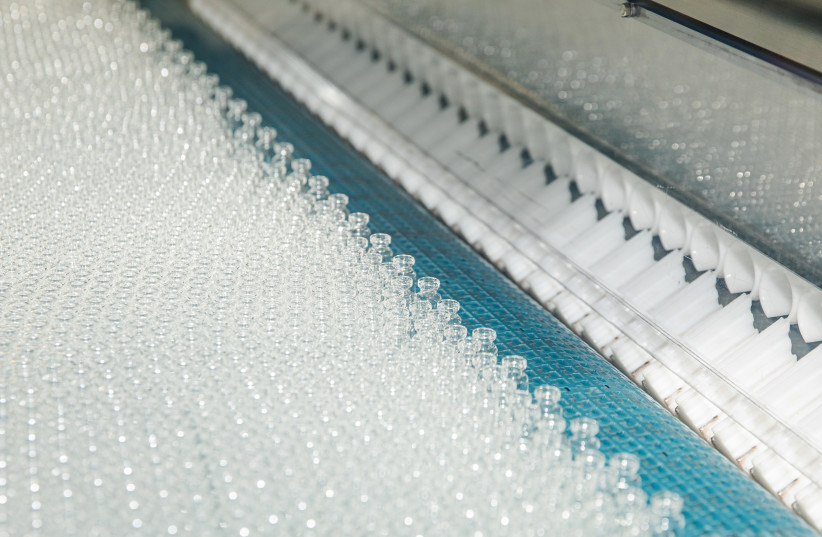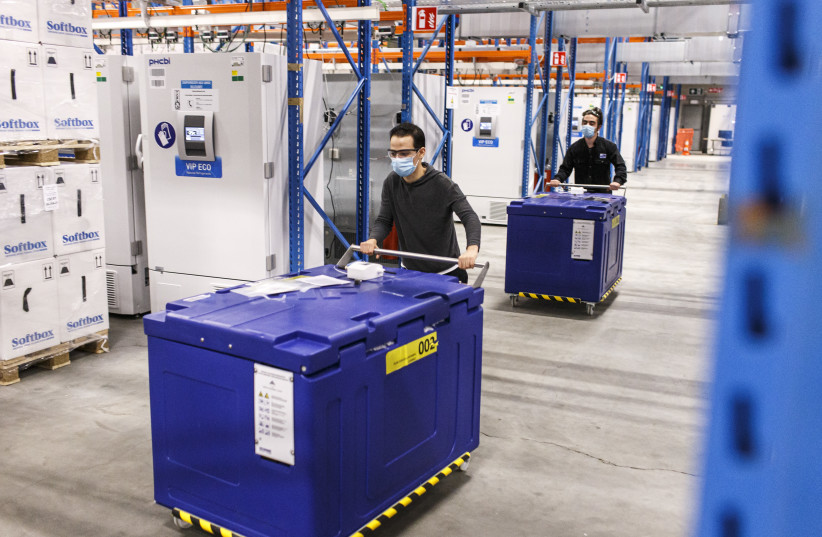Pfizer's COVID vaccine factory: Witnessing a modern miracle

Pfizer’s COVID-19 vaccine was the first shot approved by the US Food & Drug Administration (FDA) for Emergency Use, and Israel was the first country to mass vaccinate its population.
One cannot see the exact site of the parting of the Red Sea, and it is pretty expensive to travel to the moon.
So, when I was allowed to become the first Israeli journalist since the start of the corona pandemic to go inside the site where Pfizer made its COVID-19 vaccines, I jumped at the chance to witness a modern miracle.
According to a report by researchers at Sapir College, an estimated 4,750 COVID-19 deaths were avoided in Israel due to vaccinations between March 15 and June 26, 2021, alone. Worldwide, COVID vaccines saved an estimated 20 million lives in their first 18 months, according to the vaccine alliance Gavi.
Pfizer’s COVID-19 vaccine was the first shot approved by the US Food & Drug Administration (FDA) for Emergency Use, and Israel was the first country to mass vaccinate its population. On Wednesday, December 8, 2020, Israel received its first shipment of those vaccines. A yellow DHL cargo plane carrying tens of thousands of doses landed at Ben-Gurion Airport. It was met by Prime Minister Benjamin Netanyahu, who promised to vaccinate 60,000 Israelis by the end of the year.
“I believe in this vaccine,” he said in a televised speech.
Twelve days later, the prime minister became the first Israeli to get the jab. More than 6.7 million out of Israel’s 9 million citizens have been vaccinated with at least one shot since.
It all began at Pfizer’s Puurs manufacturing and packaging site in Brussels.
The facility is 60 years old and one of the company’s most prominent, specializing in aseptic production and packaging, mostly of injectables. Its core focus areas are vaccines, internal medicine, inflammation and immunology, rare diseases, anti-infectives and oncology. It is also a key launch site for the company, explained Puurs site leader Luc Van Steenwinkel, meaning it is a plant that runs clinical pilots and Pfizer experiments.
Before COVID, Puurs employed around 2,500 people. Approximately 4,500 employees work there today, producing about 400 million units annually, not including COVID-19 vaccines. Puurs ships to 175 markets globally, meaning almost everywhere.
The plant received the first call to begin manufacturing COVID-19 vaccines in mid-March 2020, Van Steenwinkel recalled. Three months later, the first manufacturing equipment arrived. Then, in July 2020, the first freezers that would store the vaccines were delivered to Puurs. And that same month, the first clinical batches were produced. By the beginning of September, the first 140-liter test batch was made.
“One hundred days from when we cut the ribbon on what would become our COVID-19 packaging and shipping warehouse, we got our first engineering batch at full scale. It was the first miracle,” Van Steenwinkel said. “It was good quality. It could have been released for injection or administration. From there, things went very fast.”
Phase 1 of the Process Performance Qualification (PPQ) protocol was completed and approved by November. The first shipments of vaccines left Puurs for the United Kingdom and the United States on November 25. The US approved the vaccine on December 11, making it the world’s first approved mRNA vaccine.
The European Union approved it on December 23.
Since then, Puurs has constantly been increasing its manufacturing capabilities, shipping most of the company’s 4.4 billion COVID-19 doses worldwide, said Koen Vastenavondt, senior director for Aseptic Manufacturing at the plant.
‘Not a desk job’
To enter a vaccine line at Puurs, you must be clean. During our visit to the Prevnar 13 line, we were asked to remove all our jewelry, wash off our makeup and remove our nail polish. In addition, we were given a double-layered sterile suit to cover our clothes, and hair nets.
Street shoes are not allowed, so we had to change our shoes twice – once to walk to the facility and a second time when we got ready to enter. And even those shoes were wrapped in a protective cover to prevent the spread of any germs. Even our pens and notepads had to be sterilized.
Producing a vaccine involves five steps, explained Tess Vanderyver, a senior vaccine production manager: sterilizing the vessels; formulating the vaccine in the vessels; transferring the vaccine from the vessels to vials; inspecting them; and then packaging them for shipment.
The formulation room is like a mass chemical kitchen, where operators methodically mix life-saving ingredients in a big metal pot. First, a neutralizing buffer solution is prepared. Next, active pharmaceutical ingredients (APIs) are added.
Humans never touch any of the raw ingredients. Instead, the ingredients start in sterile bags and are transferred to the vat via special piping. Finally, the finishing touches, such as adjuvants to enhance the immune system response, preservatives and stabilizers, are put inside.
“Everything is both manual and electronic,” Vanderyver explained.
The vaccine-making manual is built into a system, and operators must walk through every step. At least two people must work together – one reading the manual and the other doing the labor.
No one can enter the room when a vaccine is being mixed so that the workers don’t become distracted. All ingredients need to be scanned by the system before being added to the vat. This way, if a component is found to have an issue, it can be easily traced to its batch.
All the vats are on wheels. When the vials are ready to be filled, it is rolled out to a separate area of the facility and connected to an automated filling system, where tens of thousands of tiny vials move along a production line, receiving the vaccine.
One in every 100 vials is weighed multiple times to ensure that the right vaccine amount is distributed.
Although the process is electronic – even robots place the vials on the filling line – staff is bustling, constantly monitoring, re-monitoring, and performing checks and balances.
“This is not a desk job,” Vanderyver said. “Someone who works here has to be hands-on. All day and every day, there is something different to do.”
Moreover, they are highly trained. Vanderyver, for example, has a degree in biological engineering. She has been at Pfizer for 11 years. She said that “mistakes happen, but they are rare. There have been times that the bottles were not approved, and we had to throw them all out.”
Working at Pfizer at the height of the pandemic, Vanderyver said, was “a unique experience.”
“There was a global pandemic, and we were producing something everyone was waiting for,” she said. “We take a lot of pride in how we succeeded by working together. Our success was due to the efforts of everyone.”
‘It has a happy ending’
The packing and shipping plant is a short drive away on the same campus, where 2,200 ultra-low-temperature freezers line the walls.
Before the pandemic, the building was just a storage area. At the peak of COVID, the facility was shipping more than 100 million doses per month, Vastenavondt said.
Before the COVID-19 vaccine, which must be stored between -90°C and -60°C, no shot had to be kept at such cold temperatures. Therefore, the plant was not equipped to handle it. Yet, two years later, Puurs staff appeared as if they had been managing COVID vaccines forever.
The vaccines are delivered to the warehouse and loaded into freezers for three to six weeks. Each freezer is carefully labeled to ensure the shots stay within their prime. From the freezer, they are transferred into large blue chests brimming with dry ice. Those chests are then wheeled to an assembly line, where staff carefully removes each box, secures them with snap popper tape, and transfers them to a shipping carton filled with dry ice.
Each container receives a temperature tracking device to ensure the vaccines stay cold enough as they travel worldwide. Because so much dry ice is required, Pfizer makes it in the plant.
“This was all innovated in the last two years,” Vastenavondt said. “And all these people are new hires. It was not so easy to find staff during COVID. But these people are very committed. They all know why they are here.
“And, as you can see, it has a happy ending.”
Jerusalem Post Store
`; document.getElementById("linkPremium").innerHTML = cont; var divWithLink = document.getElementById("premium-link"); if (divWithLink !== null && divWithLink !== 'undefined') { divWithLink.style.border = "solid 1px #cb0f3e"; divWithLink.style.textAlign = "center"; divWithLink.style.marginBottom = "15px"; divWithLink.style.marginTop = "15px"; divWithLink.style.width = "100%"; divWithLink.style.backgroundColor = "#122952"; divWithLink.style.color = "#ffffff"; divWithLink.style.lineHeight = "1.5"; } } (function (v, i) { });


